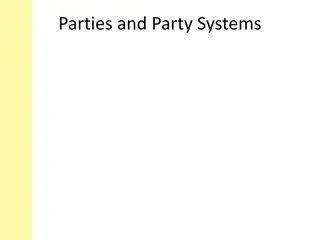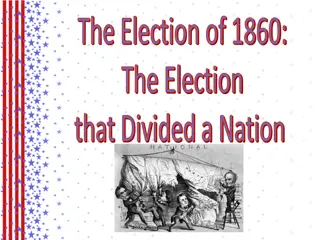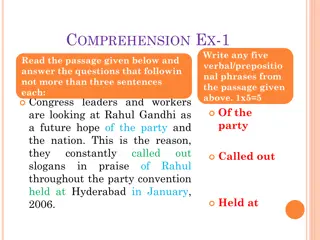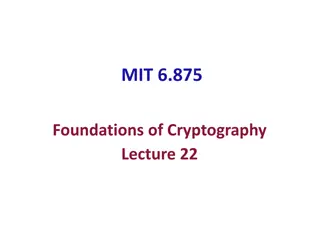The Swaraj Party: Formation, Background, and Aims
The Swaraj Party, a breakaway group from the Indian National Congress, was formed in 1923 by C.R. Das and Motilal Nehru following the withdrawal of the Non-Cooperation Movement. The party aimed for dominion status, autonomy, and self-rule, emphasizing control over bureaucracy and local bodies. The split within the Congress led to differing strategies for engaging with British governance, with the Swaraj Party advocating for participation in legislatures. This article explores the party's history, significance, and objectives in India's struggle for independence.
Download Presentation

Please find below an Image/Link to download the presentation.
The content on the website is provided AS IS for your information and personal use only. It may not be sold, licensed, or shared on other websites without obtaining consent from the author.If you encounter any issues during the download, it is possible that the publisher has removed the file from their server.
You are allowed to download the files provided on this website for personal or commercial use, subject to the condition that they are used lawfully. All files are the property of their respective owners.
The content on the website is provided AS IS for your information and personal use only. It may not be sold, licensed, or shared on other websites without obtaining consent from the author.
E N D
Presentation Transcript
Dr.AGHALYA.,M.A.,M.Ed.,M.PHIL., Dr.AGHALYA.,M.A.,M.Ed.,M.PHIL.,Ph.D Head & Head & Asst.Professor Department of History Department of History Bon Secours College for Women Bon Secours College for Women Ph.D., ., Asst.Professor Thanjavur Thanjavur
INTRODUCTION The Swaraj Party or the Congress-Khilafat Swarajya Party was formed on 1 January 1923 by C R Das and Motilal Nehru. The formation of the Swaraj Party came after various significant events like the withdrawal of non- cooperation movement, the government of India act 1919 and 1923 elections.
Swaraj Party Background How the party came into the picture can be understood by the following points mentioned below: After the Chauri Chaura incident, Mahatma Gandhi withdrew the Non-Cooperation Movement in 1922. This was met with a lot of disagreements among leaders of the Congress Party. While some wanted to continue non-cooperation, others wanted to end the legislature boycott and contest elections. The former were called no-changers and such leaders included Rajendra Prasad, SardarVallabhai Patel, C Rajagopalachari, etc.
Swaraj Party Background The others who wanted to enter the legislative council and obstruct the British government from within were called the pro-changers. These leaders included C R Das, Motilal Nehru, Srinivasa Iyengar, etc. In 1922, in the Gaya session of the Congress, C R Das (who was presiding over the session) moved a proposal to enter the legislatures but it was defeated. Das and other leaders broke away from the Congress and formed the Swaraj Party. C R Das was the President and the Secretary was Motilal Nehru. Prominent leaders of the Swaraj Party included N C Kelkar, Huseyn Shaheed Suhrawardyand Subhas Chandra Bose.
Aims of the Swaraj Party The Congress-Khilafat Swarajya Party or the Swaraj Party aimed for: Attaining dominion status. Obtaining the right to frame a constitution. Establishing control over the bureaucracy. Obtaining full provincial autonomy. Attaining Swarajya (self-rule). Getting people the right to control government machinery. Organising industrial and agricultural labour. Controlling the local and municipal bodies. Having an agency for propaganda outside the country. Establishing a federation of Asian countries to promote trade and commerce. Engaging in the constructive programmes of the Congress.
Significance of Swaraj Party Gandhiji and both the pro-changers and the no-changers realised the importance of putting up a united front in order to get reforms from the government. So, it was decided that the Swarajists would contest elections as a separate group within the Congress Party. The Swaraj Party won 42 out of 104 seats to the Central Legislature in 1923. The party s programme was to obstruct the government. They wanted to create deadlocks on every measure. They boycotted all official functions and receptions held by the government. They voiced their grievances and aspirations in the Legislative Assembly.
Swaraj Party and its Achievements SwarajistVithalbhai Patel became speaker of the Central Legislative Assembly in 1925. They outvoted the government many times even in matters related to budgetary grants. They were able to defeat the Public Safety Bill in 1928. They exposed the weaknesses of the Montagu- Chelmsford reforms. They gave fiery speeches in the Assembly on self-rule and civil liberties.
Drawbacks of Swaraj Party They could not coordinate their struggle inside the Assembly with the mass freedom struggle outside. They totally relied on newspapers to carry their work and message in the Assembly to the outside world. Some of them could not resist the perks of power. Motilal Nehru was a member of the Skeen Committee and A Ramaswamy Iyengarwas a member of the Public Accounts Committee. Their policy of obstructionism had its flaws and limitations. The death of C R Das in 1925 further weakened the party.
Drawbacks of Swaraj Party There were internal divisions among the Swarajists. They were divided into the responsivistsand the non-responsivists. The responsivists (M M Malaviya, Lala Lajpat Rai, N C Kelkar) wanted to cooperate with the government and hold offices, whereas the non- responsivists (Motilal Nehru) withdrew from legislatures in 1926. The party was in shambles when it went into the 1926 elections, and as a result, did not perform well. The party s failure to support the peasant cause in Bengal led to a loss of support of many members. The party merged with the Congress in 1930.























